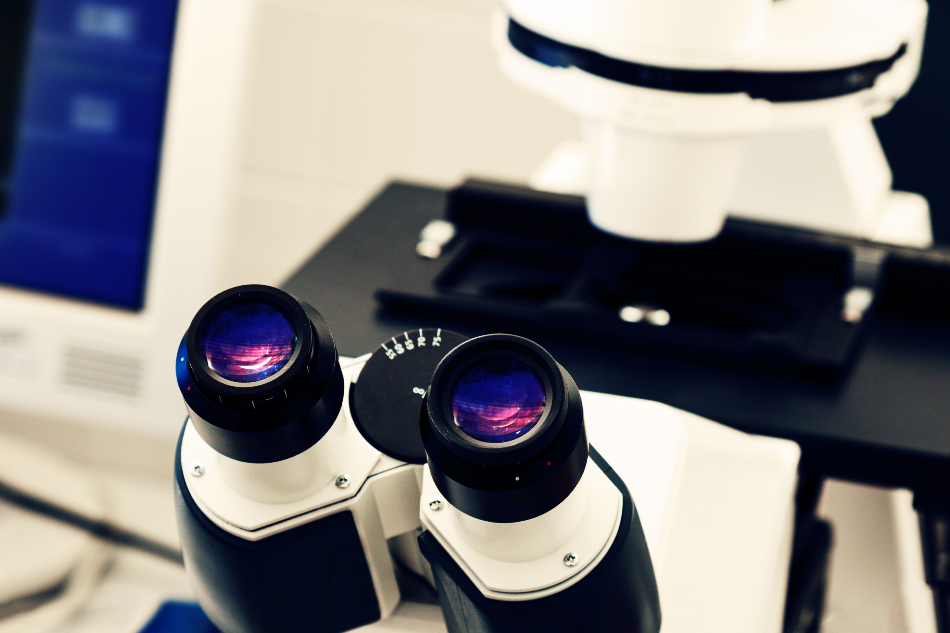
science photo / Shutterstock
Microscopy techniques have been around for many decades and are always improving. The field itself has had to improve because the samples being analyzed have been getting smaller and smaller, especially since nanomaterials have emerged into many areas of science.
All microscopy techniques have advantages and disadvantages that make them more suited to certain samples and analysis scenarios, and in this article, we’re going to look at the suitability of both optical microscopy and electron microscopy for analyzing nanomaterials.
Optical Microscopy
Optical microscopes are found in every laboratory and are used to image a wide variety of samples. They are known as light microscopes, and every scientist is likely to have used one at some point throughout their life. These microscopes use light to illuminate a sample and vary in complexity depending on the type. In short, photons of light are passed through the sample to illuminate it and a set of lenses are used to enlarge the sample as per the objective magnification.
Some microscopes use compound lenses to magnify the sample, but anyone who has used these microscopes knows that the magnification is not very high. Optical microscopes are ideal for observing samples that you can see with the naked eye but in more detail as well as micron-sized materials. However, they don’t have the ability to observe nanostructured materials in a great amount of detail, as the maximum magnification possible is only 1000 X, and the very best resolution possible is 200 nm. This is more than the dimensions of most nanomaterials, so while you can sometimes see them with an optical microscope, you can’t see the different features of the nanomaterial.
There are some adaptions that are being developed to bring the resolution down to the nanoscale range, with the addition of plasmonic gratings being one option. The initial prototypes made in the academic lab have brought the resolution down to 65 nm, so it is possible that optical microscopes could soon be a usable nanoscale microscopy technique.
Electron Microscopy
Electron microscopy (EM) encompasses a number of techniques, but the most notable are scanning electron microscopy (SEM) and transmission electron microscopy (TEM). Electron microscopy techniques are high-powered and high-resolution microscopy techniques that use electrons—instead of photons—to analyze a sample. EM techniques have become some of the most widely used microscopy techniques—alongside atomic force microscopy (AFM)—for imaging and analyzing a nanomaterial.
EM methods can be used on all nanomaterial types, and TEM is specially designed for the nanoscale as it struggles to provide a high-quality image if the sample is more than 500 nm thick. In both SEM and TEM, an electron gun fires electrons through a series of optics, and this focuses the electrons towards the nanomaterial.
In SEM, the electrons are backscattered due to surface interactions, and the interactions produce secondary electrons which are also backscattered. Both types of electrons are detected and are used to build an image. In TEM, the electrons don’t scatter, rather, they pass through the material (like optical microscopy) and are detected. Some electrons are scattered in TEM, and these electrons can be analyzed by using reflection electron microscopy (REM)—but this mode isn’t as widely used. The transmitted electrons are also used to build an image of the sample, and the electrons in both TEM and SEM contain information that can be used to provide information on the nanomaterials.
The use of different EM techniques can provide a lot of information. Naturally, it can produce a visible image of the surface, and this can also show if there is any surface contamination on the nanomaterial. The data obtained from the passing electrons can also provide information on the localized electronic properties of the nanomaterial, as well as its crystal structure, morphology, and surface stress state.
Aside from basic properties, EM methods can be used to identify a number of nanoscale features, including hierarchical structures, patterned surfaces, nano-sized pores, intrinsic nanocrystalline structures, quasi-crystalline structures, and defects. Moreover, it can be a tool that can distinguish the interfaces in hybrid and layered materials, as well as the individual components themselves—this extends out to materials that are not chemically connected, such as van der Waals (vdW) heterostructures. EM methods can be used to identify which form of a material is present in the sample—with a classic example being the analysis of carbon nanotubes (CNTs) to see if they are single-walled or multi walled-in nature.
Conclusion
Overall, the different EM methods can clearly image (with a high resolution), analyze and provide a lot of information of all types of nanomaterials, nanostructures and nanoscale surfaces, and this is one of the main reasons why they have become a staple technique in many labs that deal with nanomaterials. As for optical microscopes, they can be adapted to observe the nanoscale, but this is currently a less popular option with the other microscope technologies available nowadays.
Sources
Disclaimer: The views expressed here are those of the author expressed in their private capacity and do not necessarily represent the views of AZoM.com Limited T/A AZoNetwork the owner and operator of this website. This disclaimer forms part of the Terms and conditions of use of this website.